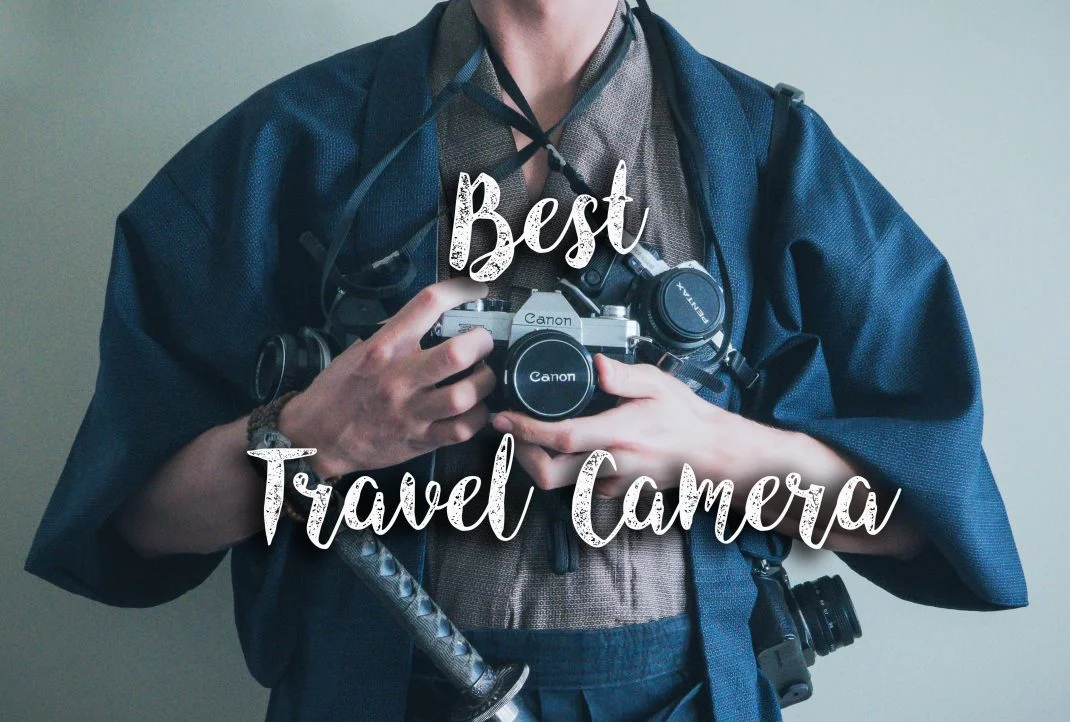Travel Photography
When you research potential travel destinations what is the first thing you do? For the majority of us we look up high-quality travel photos of our chosen location, and in return, we all hope to capture similarly stunning and powerful images to show off to our friends. This is why selecting the best travel camera for you is so important.
Your photos ignite memories of your trips abroad, they bring a smile to your face and are something to be very proud of. Without the proper information, you can, unfortunately, end up with a camera that you are unhappy with, thus leaving you with lousy photos or none at all!
After eleven years of being a self-proclaimed travel photographer, I have been through all of the trials and tribulations of finding what I believe is the best line up for travel cameras and video cams. Use these tips and tricks to help you find and pick the best travel camera!
How to Pick the Best Travel Camera?
Walk into a camera store and you will see hundreds of options of brands, sizes, lenses and price ranges that will leave you feeling incredibly intimidated. Even worse there usually is an extremely bias sales associate who is fighting the war on Nikon vs Canon who will give you plenty of tips on why you shouldn’t buy a particular brand!
This is where us travel photographer/bloggers come in handy. We have been through it all while traveling, most of us have gone through multiple cameras and tested all of the brands, Fuji, Canon, Sony, Nikon, yes I have brought them all around the world with me. But not all of us have the same needs as a travel blogger and certain ones will better suite your type of unique travel.
This guide will walk you through the steps in order to find that perfect fit for a travel camera that works best with you!
What Kind of Travel Photography do you like?
The first thing you must take into consideration is what kind of travel photography are you into? For example, I would never recommend a point and shoot camera to someone who specifically wants to photograph wildlife. Instead, I would lead them towards a camera with high-quality zoom or telephoto lens option.
Travel photography can be broken down into several categories, here are some examples of different types of travel photography:
Travel Portrait Photography – Portraits are of people, usually close-ups. I find this style of photography to work best with a focal length between 35mm and 100mm.

Travel Landscape Photography – Landscape photography is one of the most popular types, you want something with a large sensor to capture all the detail. I find that a medium range lens will often work best but you will need lots of patience as you will often need to wait for opportune light and conditions.

Travel Street Photography – Street photography is fast paced, meaning the faster the camera, the more likely you are to capture a high-quality action-packed image.

Travel Wildlife Photography – Capturing great photos of animals takes patience and more often a high powered telephoto lens. The further you are away from wildlife the more likely you are to get the shot you want.

Travel Action Photography – Action photography is usually geared towards sports, but in the travel world it’s becoming a more popular concept.

Travel Camera Features
Camera Sensor Size – The larger the sensor the better quality your images will be due to the amount of light that can be gathered on them. The more that a lens has to bend and refract the light to focus down on to a smaller sensor the more artifacting there will be in your pictures.
Megapixels – Megapixels are what make the image quality better, but first you need to look into what kind of sensor your camera has. In order for the megapixels to greater the image quality, they will need the proper sensor for their amount.
Weatherproofing – This makes the camera more likely to survive being in the rain or in a dusty environment. It does not guarantee the safety of the camera however, only it greatly increases the chance of not being wrecked.
Speed – The speed of your camera will allow you to capture images moving at a greater pace and also increase the load time allowing you to shoot multiple shots in a consecutive order. This is great for street photography.
Zoom Range – Many point and shoot cameras offer digital zoom which is pretty much the same thing as cropping in on a picture to focus in more quickly causing degradation in quality. Interchangeable lens cameras offer lenses that can increase your viewing distance to incredible lengths while still having incredible image quality. Be sure to know what you are getting before buying.
Video Quality – These days almost all the new action cameras come with 4k as do many of the mirrorless SLR cameras. On older models be sure to ask if you plan on doing lots of high-resolution video.
Wi-Fi and Bluetooth – Many cameras are coming featured with Blue tooth and WIFI, this is great as you can transfer photos wirelessly.
Interchangeable lenses – If you plan on doing several styles of photography then you will want a camera that can use multiple different lenses for different uses.
Typical Types of Travel Camera Sensors
Full Frame Sensor – This is the king of sensors. It provides the highest image quality and allows you to do major crops into your photos as a last resort. The Full Frame Sensor will also usually give your photos more dynamic range and offer a better field of view. This sensor does not come cheap however, most full frame cameras start at well over one thousand dollars.
APS-C Sensor – APS-C Sensors are the most common type. They are found in a lot of the upmarket point and shoot cameras and entry-level DSLR. The quality is still great and will be fine for most travel photographers, but there is a noticeable difference between an APS-C and a Full Frame Sensor.
1 Inch Sensor – This sensor is common in the more compact point and shoot cameras. Think of it as about half the size of most Full Frames.
1/3 Sensor (Smart Phones) – The tiny sensors found in smartphones will give you great quality pictures geared for the size of your phone screen. Uploading them you will find that the image quality is not great.

Travel Camera Sizes
This is the most important factor in my opinion. When we travel we do not want to lug around a giant and heavy camera. For years brands like Nikon and Canon have produced amazing Full Frame cameras that are incredibly large and make hauling around the world an absolute pain.
Your camera size is important and you need to look into what you are willing to carry with you every day. Big cameras are a pain to pull out of your bag as well making it a nuisance to actually take pictures. Be sure to bring your daypack or side bag to the store and see if the camera you want to buy will fit in your bag. You can also see how much it weighs when you carry it this way.
Point and shoots are compact while still providing great image quality. If you want a lightweight camera that provides high-quality DSLR photos there is a new camera to answer our prayers, it’s the Mirrorless camera.
Mirrorless or DSLR?
For years traveling with a DSLR camera would have left you stuck lugging around an over-sized and heavy burden. Now the majority of the camera brands are moving into the mirror-less world. Mirror-less Cameras tend to be about half the size of the DSLR and shoot in the exact same (if not better), image quality.
You lose the viewfinders mirrored exact image, but the digital viewfinder in many of the Mirror-less Cameras is to be honest better than real life giving you an advantage in low light conditions.
As an experienced traveler, I am telling you, mirrorless is the way to go!
Best Point and Shoot Travel Camera
Sony RX100 Series

In my opinion, this is the best value point and shoot. It has many of the features as more upmarket Sony cameras and provides great image quality while slipping easily in your pocket.
Highlights
- 4k Video (IV models and newer)
- Ultra-Fast Focusing
- 1″ Sensor
Panasonic Lumix ZS100 / TZ100

This tiny travel camera has a larger sensor and a leica lens giving it great image quality for its size.
Highlights
- 1-inch type sensor
- 4K movies
- 10x zoom lens
Best Mirrorless Travel Cameras
Sony A7 Series

Sony’s A7 Series are by far the greatest line up of full frame cameras out there for travelers. They are incredibly powerful full frame senor cameras and are affordable. They are also very compact and lightweight compared to other brands.
There are several models all giving travelers what they need. I started with the Sony A7ii before upgrading to the Sony A7rii because of its superior image quality, but every camera in this lineup is incredible. Go with what you can afford and you will be happy.
Highlights
Full Frame Sensors
Internal Image Stabilization
4k Video (A7S & A7R)
Weather-sealed Body
High Dynamic Range
Sony A6500

This mini budget version of the Sony A7 series is well worth its price. Its APS-C sensor gives it great image quality and it’s a fraction of the size of the A7 series. It’s also incredibly fast shooting at higher speeds than the A7 series. If you want compact but powerful this camera will suite you perfectly.
Highlights
- Compact
- APS-C Sensor
- 4K Video
Best Action Travel Cameras
GoPro Hero 6 Black

Completely waterproof and durable, the GoPro Hero 6 Black shoots in 4k. The Hero 6 can also be paired with the Karma Grip for incredibly smooth footage or the Karma Drone. It also has a ton of accessories you can use to hook up to helmets, bikes, cars exc. If used as a camera it also shoots high quality images making it one of the best cameras for drone photography. For speed, it can shoot in 4K30 and up to 120fps in 1080p
GoPro Hero Session

If you are on a tight budget this little guy will give you decent footage, but the best advantage the GoPro Hero Session has to offer is its size. It feels almost like a secret agents spy cam. It can be great fun if you are traveling with a group of people and just want to record some hilarious moments.

Best Drone for Travel Photography

Drone videos and photography is definitely trending in the travel world. There are some things you must take into consideration if you decide to travel with one.
First, check the destination in which you are going, many countries have banned drones and will confiscate them when you enter, they will not return it as well.
Second, Drones are quite big and bulky, they will most likely take up a lot of room in your bag, so consider shopping for a smaller one.
I am new to the drone world, but after playing with a few one stood out above the rest with its ultra portability. The DJI Spark. This drone will set you back about 600$ and features 1080p footage and a 12mp camera. What I like about it most is its size.

How Many Lenses should you Bring Traveling?
This is the most common question I get asked, and for good reason! If you need the zoom for animal photography you will most likely have to bring a second lens, but for me, one really high quality lens is enough.
I enjoy portrait, landscape and street photography. I also like wildlife photography and only bringing one lens doesn’t mean I can’t do it, it just means I’ll have to work a bit harder to get the shots I want. The most important factor for me is weight. If I carry around a lot of lenses I wouldn’t enjoy travel photography as much as I do and I probably would have missed many of my most famous shots.

For me, my Zeiss 16 – 70 mm provides me with all I need and doesn’t weigh my bag down. Another reason why I like to travel with just one lens is security. Lenses are very expensive, and carrying a bunch of pricey lenses around can make you an obvious target in many places for theft.
What Travel Cameras Do I Use?
I often get asked what gear I use specifically and here is my answer to that question 🙂
Sony A7rii
GoPro Hero 6 Black
Sony Zeiss 16-70mm Lens
DJI Spark Drone






Comprehensive and excellent read. Thank you for such a detailed and useful post. Definitely looking at a Sony a7 for my next camera.
Thanks for being such a great member of the Travel Blogger Tales group too!
Thanks for this. Very helpful.
For those on a budget the SJ Cam S7 is a great alternative to the go pro. I use that and get great results. Especially when connected to a gimbal and mono pod
Glad I could help 🙂 Thanks for the recommendation, I’ve never tried one out myself but I might have to check it out!
What a great article you write up! Such a awesome information and detail. Thank you so much for sharing a fantastic post..
Keep posting!
Great read. Very thoughtful and well researched.
Thanks for the comment! I’m glad you liked it 🙂
This makes strange sense to me. I get trying to be lightweight and sometimes use the (not so great) 16mm pancake that I have from my NEX-5 on my A7, but then you’re loosing out on the MP count. Not such a big deal on the A7, but on the A7r, I’m assuming you want to use all the crazy MP count. With the 16mm-70mm (functioning really as a 24mm-105mm lens in crop mode), what’s your thought on this loss of resolution? Wouldn’t it make some sense to just pair the 16-70mm Zeiss with the A6500 or A6300 maybe?
Curious mostly because I just picked up the 24-105 G OSS to pair with the A7 as my walk-around and, for weight purposes, nearly went with this solution.
A Camera is always a perfect accessory for travel. Your travel is always incomplete without a perfect camera. Thanks for sharing such useful information.